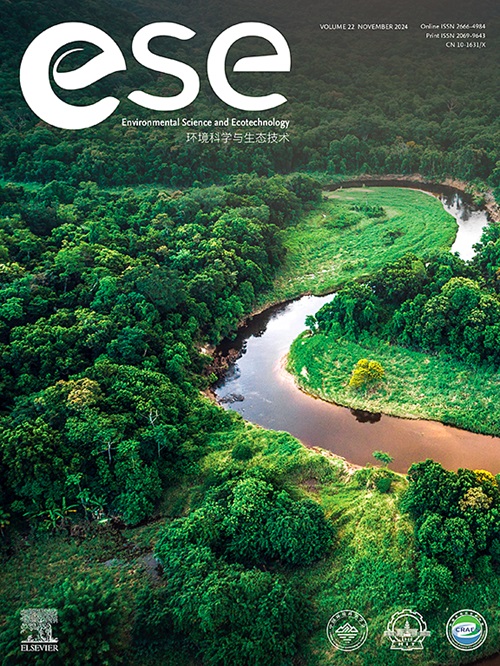Stable phytoplankton community compositions in Lake Mead (Nevada-Arizona, USA) during two decades of severe drought
IF 14.3
1区 环境科学与生态学
Q1 ENVIRONMENTAL SCIENCES
引用次数: 0
Abstract
Lake Mead, a large reservoir on the Colorado River and a critical drinking water source for the southwestern United States, typically exhibits high water quality, characterized by low nutrient and chlorophyll-a concentrations. This stability persists despite the inflow of highly treated wastewater since the 1960s and significant water level declines since 2000, driven by the ongoing Megadrought and basin-wide consumptive use. Such environmental changes may alter phytoplankton communities, potentially leading to increased cyanobacteria abundance, which could negatively impact water quality and the aquatic ecosystem through harmful algal blooms and toxin production. Here we analyzed 17 years of phytoplankton community structure and chlorophyll-a concentrations in Lake Mead, alongside quantitative water quality data, including nutrients, temperature, and water clarity, to assess the effects of environmental changes on phytoplankton communities. Contrary to the hypothesis that cyanobacteria abundance would have increased throughout the reservoir, our results indicate that phytoplankton community structures have remained largely stable, except for shallow areas where increases in temperature or phosphorus levels were observed. Additionally, we evaluated machine learning models for predicting changes in phytoplankton community structures. While the models confidently predicted changes in total phytoplankton biovolume and chlorophyll-a concentrations within the input parameter boundaries, predictions of peak biovolume showed considerable uncertainty, emphasizing the importance of incorporating uncertainty analysis in forecasting and communicating results. This study underscores the current buffering capacity of large, oligotrophic reservoirs like Lake Mead to maintain stable phytoplankton communities despite environmental changes. However, it also highlights the potential for significant community shifts if this buffering capacity is exceeded.
二十年严重干旱期间米德湖(美国内华达州-亚利桑那州)稳定的浮游植物群落组成
米德湖是科罗拉多河上的一个大型水库,也是美国西南部的重要饮用水源,水质通常很高,营养物和叶绿素-a 浓度都很低。尽管自 20 世纪 60 年代以来,经过高度处理的废水不断流入,而且自 2000 年以来,由于持续的特大干旱和整个流域的消耗性使用,水位显著下降,但这种稳定性依然存在。这种环境变化可能会改变浮游植物群落,从而可能导致蓝藻丰度的增加,而蓝藻丰度的增加可能会导致有害藻类大量繁殖并产生毒素,从而对水质和水生生态系统造成负面影响。在此,我们分析了米德湖 17 年来的浮游植物群落结构和叶绿素-a 浓度,以及定量水质数据(包括营养物质、温度和水透明度),以评估环境变化对浮游植物群落的影响。与蓝藻丰度会在整个水库中增加的假设相反,我们的研究结果表明,浮游植物群落结构在很大程度上保持稳定,只有在温度或磷含量增加的浅水区除外。此外,我们还评估了预测浮游植物群落结构变化的机器学习模型。虽然这些模型能准确预测输入参数范围内浮游植物总生物量和叶绿素-a 浓度的变化,但对生物量峰值的预测却显示出相当大的不确定性,这强调了在预测和交流结果时纳入不确定性分析的重要性。这项研究强调了米德湖等大型寡营养型水库目前的缓冲能力,可以在环境变化的情况下保持稳定的浮游植物群落。不过,它也强调了如果超过这种缓冲能力,群落可能会发生重大变化。
本文章由计算机程序翻译,如有差异,请以英文原文为准。
求助全文
约1分钟内获得全文
求助全文
来源期刊

Environmental Science and Ecotechnology
Multiple-
CiteScore
20.40
自引率
6.30%
发文量
11
审稿时长
18 days
期刊介绍:
Environmental Science & Ecotechnology (ESE) is an international, open-access journal publishing original research in environmental science, engineering, ecotechnology, and related fields. Authors publishing in ESE can immediately, permanently, and freely share their work. They have license options and retain copyright. Published by Elsevier, ESE is co-organized by the Chinese Society for Environmental Sciences, Harbin Institute of Technology, and the Chinese Research Academy of Environmental Sciences, under the supervision of the China Association for Science and Technology.
 求助内容:
求助内容: 应助结果提醒方式:
应助结果提醒方式:


